Campus News
This is UCSC
A roundup of UCSC news stories
Making game makers

Students in the new master’s degree program will learn all aspects of game development. (Photo by Elena Zhukova) |
UCSC has established a new master’s (M.S.) degree program in games and playable media offered from the UCSC Silicon Valley site in Santa Clara.
The 12-month professional degree program, administered by the Department of Computer Science in the Baskin School of Engineering, will give students a strong background in advanced technologies used in the development of computer games and other interactive media.
“Students will develop strong design skills as well as strong technical implementation skills,” said Jim Whitehead, professor and chair of computer science. “They will learn to be independent game makers, and they can go on to work in the game industry or for the growing number of companies outside the game industry that are looking for people with the combination of technical and design skills needed to create compelling interactive experiences.”
The new degree program builds on UCSC’s strength as a leading center for computer game research and education.
$300K grant for language study
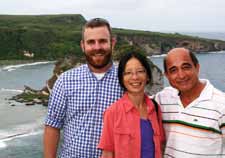
UCSC humanities professors Matthew Wagers (left) and Sandra Chung (center), with author and educator Manuel F. Borja |
UCSC humanities professors Sandra Chung and Matthew Wagers have been awarded a $300,000 grant from the National Science Foundation to investigate language comprehension in the Mariana Islands.
The project will focus on the study of Chamorro, an Austronesian language of Micronesia, spoken by 45,000 people in the Mariana Islands, which are part of the U.S. and its possessions.
The project for the 2013 NSF grant is intended to broaden the empirical base of research on language comprehension.
The UCSC professors will undertake experimental studies that build on special linguistic features of Chamorro to uncover how Chamorro speakers comprehend their language in real time.
They will explore how speakers make predictions as they hear a sentence about how the sentence will continue.
The study of language comprehension has the potential to shed light on how the mind integrates general knowledge with past experiences to deal with new situations.
Dancing queen

Ronan (Courtesy pinnipedlabs.ucsc.edu, NMFS permit 14535) |
Move over parrots, there’s a new animal on the dance floor.
Her name is Ronan, and she’s a California sea lion at Long Marine Lab. Scientists at the lab trained Ronan to bob her head in time with rhythmic sounds, then showed that she could transfer this skill to tempos and music she hadn’t heard before.
Ronan is the first non-human mammal convincingly shown to be able to keep the beat. Scientists call it “rhythmic entrainment,” and aside from humans it was previously seen only in parrots and other birds with a talent for vocal mimicry.
Ronan’s sense of rhythm undercuts an increasingly influential theory that beat keeping requires a capacity for complex vocal learning, according to Peter Cook, a graduate student in psychology and first author of the study, published in April in the Journal of Comparative Psychology.
Ronan’s favorite tune appears to be Earth Wind & Fire’s “Boogie Wonderland.” Watch the video.
Dead art comes alive at new exhibit
 |
The second annual exhibition of The Grateful Dead Archive is now open to the public at UCSC’s McHenry Library.
Songs of Our Own: The Art of the Grateful Dead Phenomenon features more than 158 primary works, plus 110 digital images, with signature pieces by band members Jerry Garcia, Mickey Hart, and Bill Kreutzmann, as well as works from numerous Deadhead artists.
The exhibition is curated by UCSC’s Grateful Dead Archivist Nicholas Meriwether.
Documenting the extraordinary art that celebrates the band, the works range from Garcia’s student days at the California School of Fine Arts, to the poster renaissance of Haight-Ashbury in the 1960s, to the increasingly sophisticated art created by both fans and band members over the past four decades.
¡Qué bien! New Spanish studies degree
Beginning this fall, students at UC Santa Cruz can declare a major in Spanish studies, leading to a new bachelor of arts degree.
Administered by UCSC’s Language Program in the Humanities Division, the faculty affiliated with the major will come from 10 departments across three divisions.
The interdisciplinary major in Spanish studies is designed to offer students the linguistic competence and cultural literacy required to understand the perspectives of diverse Spanish-speaking communities.
The major will help students gain a broad understanding of the historical and cultural developments of the countries in which Spanish is a national language, as well as those regions in which Spanish is employed in contact with other languages.
The Farm grows

Farm apprentices harvesting in July (Photo by Abby Huetter) |
The UC Santa Cruz Farm sprouted a new fence line this spring.
Looking west from Coolidge Drive, new deer fencing is visible surrounding the “hay barn” field, a three-acre addition to the Farm’s existing 25 acres.
Combined with the “lower quarry” field, bordered by the bike path and Hagar Drive, the Center for Agroecology & Sustainable Food Systems (CASFS) is adding five new acres for organic farming, research, and training.
“Five acres may not sound like much, but that’s about a third again as much land as we are actively cultivating down on the Farm,” said CASFS Executive Director Daniel Press. “This acreage will allow us to dedicate the existing fields for production while we try out new crops and research and teaching techniques on the new fields.”
Cover coup
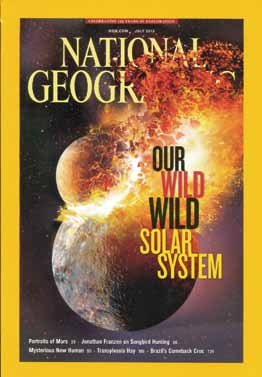 |
As a kid growing up in Vermont, Rob Irion would snuggle into his father’s recliner and pore through the pages of National Geographic magazine. He’d marvel at stories of exploration and scientific achievement, and dream that, one day, he’d see his own name on the cover of the venerable magazine.
Forty years later, Irion’s dream came true. The director of UC Santa Cruz’s Science Communication Program saw his 18-page article on the violent origins of our solar system grace the cover of the July 2013 issue of National Geographic.
It’s an achievement Irion—who has penned stories for Discover, Smithsonian, New Scientist, and Sky & Telescope magazines, among others—calls the pinnacle of his career.
Finding the correlations
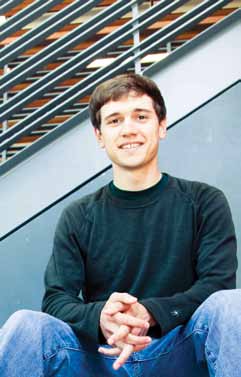
Emerson Glassey (biochemistry and molecular biology major, bioinformatics minor) (Photo by Carolyn Lagattuta) |
Emerson Glassey was only 16 when he arrived on the UC Santa Cruz campus.
He’d finished high school in two years, gone to junior college, and begun looking for a university to attend. Despite a stack of applications, however, only UC Berkeley and UCSC accepted the teen. UCSC was his pick.
Other schools’ rejections were UCSC’s gain. The 19-year-old, who graduated this year, completed a project with UCSC Assistant Professor of Chemistry Roger Linington that may change the way researchers discover compounds in marine bacteria for use in the development of new drugs.
The biochemistry and molecular biology major, and bioinformatics minor, has his eye on research and teaching at a university some day.
Child’s play = new research
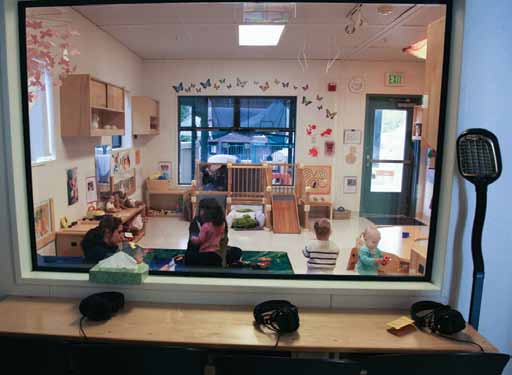
The new child-study room allows developmental psychology students a place to practice scientific observation. (Photo by Carolyn Lagattuta) |
Standing in the colorful toddler room of UC Santa Cruz’s Early Childhood Education Center, a small girl discovers a view of her elbow in a pink hand mirror. Her brow furrows as she studies the previously unexamined joint. She turns the mirror toward her toes, then her knees—and breaks into a grin.
It’s one of those wonderful moments in childhood development that might have gone unnoticed—except for a new child-study observation room installed last year at UCSC’s busy Early Childhood Education Center as part of a $165,000 grant from the Claire Giannini Fund.
The room, remodeled at a cost of $30,000, not only allows UCSC advanced developmental psychology students a place to readily practice scientific observation but also lets Early Childhood Education Center staff hone their skills, permits parents to observe their children, and facilitates faculty research.
“It’s a bridge to research and teaching,” says Early Education Services Director Sohyla Fathi.
Partnership protects puma
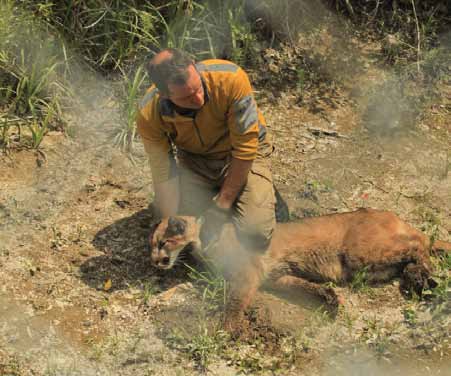
Paul Houghtaling, a wildlife biologist with the UC Santa Cruz Puma Project, holds a young mountain lion’s head up after the animal was tranquilized in a downtown aqueduct. (Photo by Chris Fust) |
The capture in downtown Santa Cruz and resettlement of a young male mountain lion in May is one of the first tests of a new state policy that calls for using non-lethal methods when mountain lions are discovered in populated areas.
It was a good example of cooperation between police, the California Department of Fish and Wildlife, researchers at UC Santa Cruz, and other agencies and organizations, said Chris Wilmers, associate professor of environmental studies at UCSC.
“It worked out well; it was a good way to handle the problem without having to shoot the animal,” said Wilmers, who heads the UC Santa Cruz Puma Project—a study that captures mountain lions in the Santa Cruz Mountains and releases them with collars that record and transmit their movements.
Previous cases when police or game wardens shot and killed lions who wandered into residential areas prompted outcries and led to a new policy.
Police and wildlife officials called Wilmers and his UCSC colleagues, along with Wildlife Emergency Services, a Moss Landing nonprofit, after the young lion was discovered in a concrete aqueduct near a busy Santa Cruz intersection.